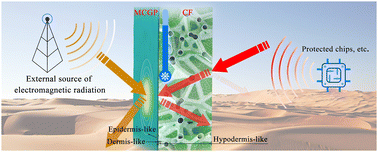Electromagnetic interference (EMI) shielding is essential for protecting the biological and electronic devices from electromagnetic waves (EMWs). However, studies on thermogenesis of the material during EMI shielding have been neglected thus far. Herein, a green method was developed to prepare a skin-like EMI shielding material composed of metal copper/carbon nanotubes (CNTs)/graphene paper (MCGP), where the metal copper was attached to the surface of the CNTs/graphene composites layer, similar to the epidermis and dermis of skin, respectively. MCGP exhibited low thermogenesis during EMI shielding, and the energy absorption efficiency (Eae) of the MCGP was calculated to be 0.30 W m−2 at an ambient electromagnetic power density of 100 W m−2. When the MCGP and polydimethylsiloxane (PDMS) were prepared as a 1 mm thick composites, its theoretical temperature rise rate (TR) was only 0.021 °C min−1 at 100 W m−2. Furthermore, the MCGP/CF/PDMS composites prepared by combining MCGP with PDMS and CNTs/graphene foam (CF, which is similar to the hypodermis of the skin), showed a high EMI shielding effectiveness (SE) of 70.2 dB at 8.2 GHz. The calculation results show that when EMWs were incident to the side of MCGP, the composites still maintained a low theoretical TR of only 0.012 °C min−1 at 100 W m−2. In conclusion, the development of MCGP provides a paradigm for reducing the thermogenesis of EMI shielding materials and has great potential to improve the performance stability of shielding materials.

